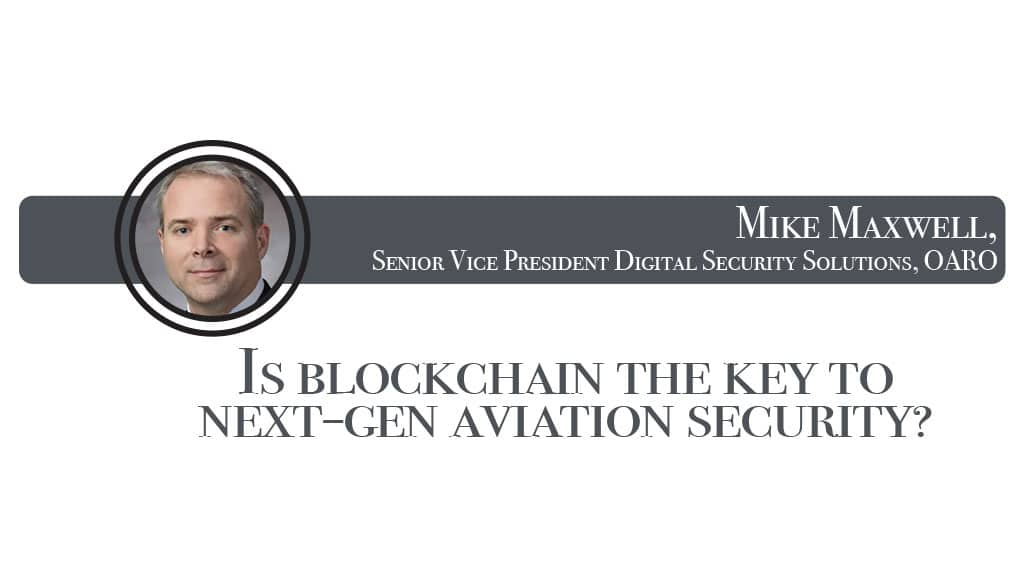You can’t talk about aviation without discussing security, which is why blockchain will play an increasingly vital role in aviation security in the future.
When people hear the word blockchain their mind immediately springs to cryptocurrencies or digital art — but there’s much more to blockchain than Bitcoin or ‘Bored Ape’ NFTs. A blockchain system is able to collect information and group it together in ‘blocks’. These blocks are then closed, un-editable, and securely linked to another previously closed block to form a ‘blockchain’.
It’s a data structure that groups together information into blocks forming a long chain, which makes the data structure of this digital ledger immutable. A system like this could not only help with tracking baggage and cargo but it has huge potential to aide in regulatory compliance and security too. A blockchain also acts as an indisputable data timeline — each block has an exact timestamp of when it was added to the chain, so for every new piece of data added is there for all to see in its original state.
Now imagine a blockchain based digital identity. A system like this could increase efficiency and security, improving the passenger journey and ensuring restricted areas of airports are even more secured, controlled and monitored.
Keeping the Door Locked
Blockchain technologies have already been deployed at several airports. Take Saint John Airport in Eastern Canada, for example. At this regional airport they have installed a blockchain backed access management system, providing a secure and seamless entry system for airport workers and contractors.
The system uses full-motion video, which eliminates the need for swipe cards and keys and the security risk of loss and theft that they pose. The video monitoring also stops would-be bad-actors from gaining unauthorized access using high-resolution photographs. The user is authenticated in real time and the information related to their access — date, time, location — is stored as a tamper-proof record in the blockchain. When a new employee joins the airport or contractors, and suppliers are needed on site, they can be onboarded almost instantaneously, and their digital identity added to the system alongside the relevant permissions to access the areas they need. An easily scalable, entirely secure system that can not only improve efficiency but most importantly, increase security.
What’s Next?
So where can this “easily scalable, entirely secure system” go next? Well, it doesn’t have to stop at airport staff, Biometric Passenger Processing or in other words, touchless boarding using a digital identity.
The passenger journey is changing constantly as airports wrestle with improving capacity, efficiency, security, and comfort all at once. Blockchain solves several problems when it comes to digital identities for passengers. The first is the same security benefits when used for airport employees — a tamper-proof record of access and travel, stored securely with dates, times and locations. This gives airports, customs and border services, and law enforcement the ability to verify quickly and without doubt in cases of a security breach.
Blockchain adds an extra layer of security, providing the digital signatures and data certification needed to create the level of trust necessary for travelers to confidently enroll and share personal information. This also helps ensure relevant data protection and privacy regulations such as GDPR or PIPEDA are followed ensuring the traveler is always in control of their personal data.
A digital identity system for passengers is already being trialed by Canadian airline WestJet, who recently launched a “Trusted Boarding” scheme. The first of its kind in Canada, the system verifies a passenger’s identity prior to boarding using facial verification technology.
Crucially, one of the key benefits of biometric passenger processing is that it allows the passenger to stay in control of their own data. Currently at most airports, passengers are expected to share vast amounts of (often unnecessary) personal data with airlines and airport authorities with no control over what information is shared and when. With blockchain-powered biometrics, they only have to share the necessary information when they have to, in a secure manner.
Where Else Does Blockchain Fit?
While identification may be the primary application for blockchain at the moment, there are still many ways the technology could improve aviation security in the longer term. Airspace management, flight data management, air frame manufacturing and airport operations are all areas that could reap the benefits of blockchain.
Take supply chain as an example — blockchain is the most efficient and secure way to increase transparency and implement the effective monitoring of an entire supply chain. It can cover the tracking of cargo, backed with an immutable ledger of record, easily auditable, ensuring complete accountability. Providing secured information access to all the participants in the movement of goods.
Now apply this to cargo or even airplane manufacturing. Every nut, bolt and liter of fuel that goes into an airplane can be monitored, accounted for and tracked — all backed by an immutable ledger of record. The fear of counterfeit or fraudulent parts is totally removed. That’s what blockchain provides.
And that’s only the start of where blockchain can fit into the aviation sector beyond the current trials and installations. Anywhere within the industry that requires large amounts of data or relies on pencil and paper records could be brought into the 21st century with the correct implementation.
